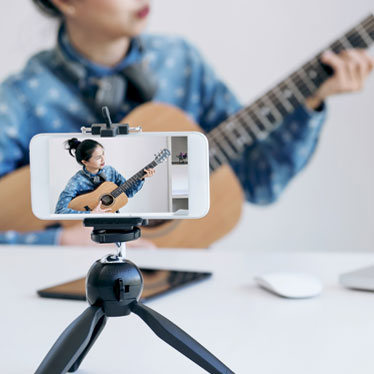6 Tips On Preparing Your Music College Application Video

In a perfect world, musicians would have the funds to audition - and tour - their dream music schools in person. This gets pricey and time-consuming if your top choices are far away. Fortunately, schools allow you to audition via video - but that means you have to ensure your finished AV file is good enough for your talent to transcend the digital chasm between you and the judges.
The following tips will help you put together an audition video you feel 100% confident in - knowing you put your very best string forward!
1. Follow the specific instructions for each school
Check out our helpful article, Tips on Writing Your Music School Application, where we shared this same piece of advice: when applying to multiple schools, it’s easy to lose sight of who wants what – but that can cost you points from the admissions counselors.
Pay close attention to the instructions from each school – no matter how similar they are – so your audition tape meets their exact requirements. This means that one audition video may not “fit all,” so be prepared to make a few different versions depending on the length of the audition required and other instructional parameters.
2. Produce a high-quality video
The good news is that new, high-tech, gadget video recorders, and even your 4k video iPhone, are surprisingly high quality. There’s no need to pay a professional videographer to record the video for you. However, the space in which you create your video can diminish the quality of the final product’s looks and sound.
- Record in the right space. You’ll want a space big enough that your mic can be about the same distance from you as an audience member would be at a recital, but small enough that the sound waves aren’t reverberating in a cave-like atmosphere. A living room is often the best bet.
- Think about sound. Using blankets, pillows and other absorptive materials, you can create an amateur version of a soundproof room – blocking exterior sounds (sirens, traffic, the neighbor’s TV, etc) and creating a more focused sound from your instrument to the mic. Read, How to Practice at Home Without Making Your Family Crazy for soundproofing tips that apply to audition recordings as well.
- Don’t forget about the lighting. You’ll want the majority of the lighting to come from the front and sides. If the light comes through from the back, you’ll disappear, and the video will appear dark and fuzzy. Diffused, natural light is optimal.
3. Ask around for recording equipment
Unless you plan to record music frequently, there is no need to invest in recording equipment. Instead, ask around. Odds are your teacher(s) or someone in your orchestra has everything you need and will be more than willing to loan or rent it to you (or do the recording work for you) for free, some bartering, or a reasonable price.
4. Choose someone you trust to be there with you
At best, a friend or family member can help monitor sound output and the recording equipment levels. However, even the least techy person will come in handy, providing emotional support and helpful feedback as you work to create the most perfect recording you can produce.
5. Take advantage of free music editing apps
Music schools have strict rules about editing – for instance, you can’t splice out the mistakes from one recording and swap them with music perfect recordings in another. However, you can take advantage of free music editing apps such as Garageband to create MP3 (or other specified) files, put all of your recording submissions together with small pauses, and to sync your video and audio recordings together. This way it doesn’t look like sound was dubbed in. What the admissions panel hears should match what they see on the screen.
6. Send the Final Recording in the format specified, before the deadline
Finally, we loop back to #1 - Follow the Instructions! Make sure you send your music school audition via the format they requested – DVD, CD, YouTube link, zip file, etc.
And, while USPS, FedEx, and other shipping companies are very reliable, accidents do happen. Always complete and send your audition off well before the deadline, so you have time to send another if it is accidentally lost in the mail or doesn’t get into the right hands.
The team at StringOvation wish you the best of luck as you pursue acceptance at your dream music school!


